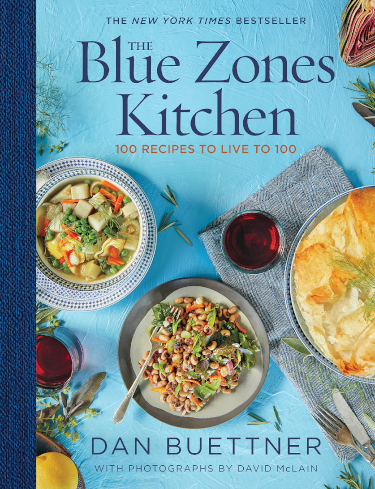Here’s a new one to me, a catch phrase that describes places on earth where people just naturally live to 100 or older. They’re called Blue Zones and they have a lot to tell us about healthy eating.

Now, you can find out about them in a cookbook.
The similarity in Blue Zones’ traditional diets tends to indicate that what they eat contributes in a big way to their longevity. And given that Blue Zone diets are also eerily parallel to the latest recommendations diet and nutrition experts are making also supports the idea that Blue Zone Eating may be a perfect way to get into the Mediterranean Diet!
Blue Zone secrets…
That cookbook I mentioned is The Blue Zones Kitchen: 100 Recipes to Live to 100 by Dan Buettner, who first identified Blue Zones in his National Geographic articles and later books, codifies some tips and recommendations for longer life:
The Blue Zone countries/regions include: Ikaria, Greece; Okinawa, Japan; Nicoya, Costa Rica; and Loma Linda, California. They’re all warm-weather spots. A recent CNN review of Buettner’s findings by Sandee Lamott notes: “People in Blue Zones walk, garden and bike as part of their daily lives. They are close to friends and family, have a purpose in life, handle stress well, and are often members of a social or religious group. They eat a plant-based diet and stop eating before they are full.”
(See also: The Blue Zones American Kitchen © 2022 – Dan Beuttner. Featuring the cuisine of U.S. micro Blue Zones.)
Eating patterns simple and specific
“The blue zone eating pattern is 98 percent plant-based foods — whole food-based and high carbohydrate. But only complex carbs, not the simple carbs like salty snacks and candy bars and soda pop,” Buettner told Lamotte. “You say carbohydrates and people are horrified, but the healthiest foods in our food system are complex carbohydrates.”
“Complex carbohydrates, such as beans, peas, vegetables and whole grains provide vitamins, minerals and fiber that can go missing in processed and refined foods,” Lamotte explains. “In addition, they are digested more slowly, and the fiber helps you feel full longer, according to the American Heart Association.”
“The five pillars of every longevity diet, including the Blue Zone, are whole grains, vegetables in season, tubers, nuts and beans,” Beuttner proclaims. “In fact, I argue the cornerstone of a longevity diet is beans.” Beuttner believes specifically in blue and purple potatoes.
Echoes of the Med Diet
In some respects, but the similarities may only be superficial…
The Blue Zone Diet (as we’ll call it from time to time herein after) includes less fish than the Med prescribes. On average meat is eaten only three times a week, and in small portions (3 oz. / 85 g). And meat is eaten only five times a month.
“People in Blue Zones don’t eat nearly as much fish as the Mediterranean diet prescribes, at only three times a week and in only 3 ounce portions,” Beuttner says. “And there’s no cow’s milk in any Blue Zone. Instead, people consume goat and sheep’s milk, in the form of cheeses such as Feta and Peccorino.
In summation
Beuttner boasts: The 100 Blue Zone meals in his cookbook are all quick and easy to make – less than 20 minutes prep and under$2. per serving. They can all be made ahead and frozen without losing any of their nutrients, bold colours or flavours.
In addition, they’ll, “leave you feeling better and […] taste a lot better than a hamburger,” Buettner adds. “What’s to lose?”
~ Maggie J.

